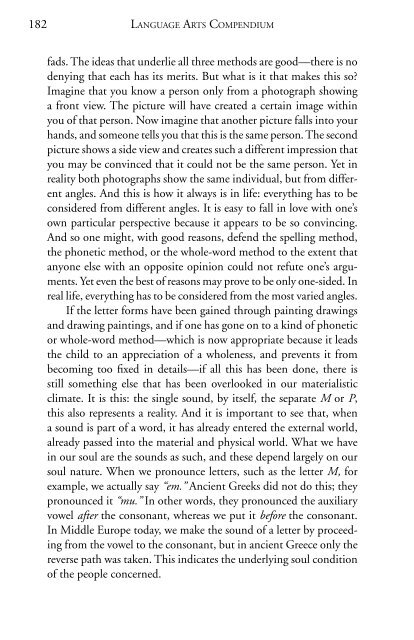Teaching Language arTs in The WaLdorf schooL
Teaching Language arTs in The WaLdorf schooL
Teaching Language arTs in The WaLdorf schooL
Create successful ePaper yourself
Turn your PDF publications into a flip-book with our unique Google optimized e-Paper software.
182<br />
<strong>Language</strong> Arts Compendium<br />
fads. <strong>The</strong> ideas that underlie all three methods are good—there is no<br />
deny<strong>in</strong>g that each has its merits. But what is it that makes this so?<br />
Imag<strong>in</strong>e that you know a person only from a photograph show<strong>in</strong>g<br />
a front view. <strong>The</strong> picture will have created a certa<strong>in</strong> image with<strong>in</strong><br />
you of that person. Now imag<strong>in</strong>e that another picture falls <strong>in</strong>to your<br />
hands, and someone tells you that this is the same person. <strong>The</strong> second<br />
picture shows a side view and creates such a different impression that<br />
you may be conv<strong>in</strong>ced that it could not be the same person. Yet <strong>in</strong><br />
reality both photographs show the same <strong>in</strong>dividual, but from different<br />
angles. And this is how it always is <strong>in</strong> life: everyth<strong>in</strong>g has to be<br />
considered from different angles. It is easy to fall <strong>in</strong> love with one’s<br />
own particular perspective because it appears to be so conv<strong>in</strong>c<strong>in</strong>g.<br />
And so one might, with good reasons, defend the spell<strong>in</strong>g method,<br />
the phonetic method, or the whole-word method to the extent that<br />
anyone else with an opposite op<strong>in</strong>ion could not refute one’s arguments.<br />
Yet even the best of reasons may prove to be only one-sided. In<br />
real life, everyth<strong>in</strong>g has to be considered from the most varied angles.<br />
If the letter forms have been ga<strong>in</strong>ed through pa<strong>in</strong>t<strong>in</strong>g draw<strong>in</strong>gs<br />
and draw<strong>in</strong>g pa<strong>in</strong>t<strong>in</strong>gs, and if one has gone on to a k<strong>in</strong>d of phonetic<br />
or whole-word method—which is now appropriate because it leads<br />
the child to an appreciation of a wholeness, and prevents it from<br />
becom<strong>in</strong>g too fixed <strong>in</strong> details—if all this has been done, there is<br />
still someth<strong>in</strong>g else that has been overlooked <strong>in</strong> our materialistic<br />
climate. It is this: the s<strong>in</strong>gle sound, by itself, the separate M or P,<br />
this also represents a reality. And it is important to see that, when<br />
a sound is part of a word, it has already entered the external world,<br />
already passed <strong>in</strong>to the material and physical world. What we have<br />
<strong>in</strong> our soul are the sounds as such, and these depend largely on our<br />
soul nature. When we pronounce letters, such as the letter M, for<br />
example, we actually say “em.” Ancient Greeks did not do this; they<br />
pronounced it “mu.” In other words, they pronounced the auxiliary<br />
vowel after the consonant, whereas we put it before the consonant.<br />
In Middle Europe today, we make the sound of a letter by proceed<strong>in</strong>g<br />
from the vowel to the consonant, but <strong>in</strong> ancient Greece only the<br />
reverse path was taken. This <strong>in</strong>dicates the underly<strong>in</strong>g soul condition<br />
of the people concerned.

















